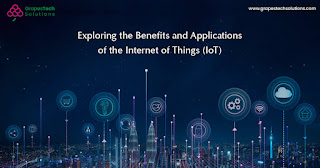The Internet of Things (IoT) refers to the interconnectivity of physical devices, vehicles, buildings, and other items that are embedded with sensors, software, and network connectivity, enabling these objects to collect and exchange data. IoT allows for the creation of smart systems that can make our lives easier, safer, and more efficient.
The concept of IoT has been around for several decades, but it wasn’t until the early 2000s that advances in technology and the widespread adoption of the internet made it possible to realize its potential. Since then, IoT has continued to evolve and expand, with more and more devices being connected to the internet every day. Today, IoT has the potential to transform industries and society as a whole, and it is rapidly becoming a key component of the digital revolution.
IoT is made up of several components, including devices, sensors, actuators, and network connectivity. These components work together to collect and exchange data, allowing for the creation of smart systems that can monitor and control various aspects of our lives. For example, a smart home system might use sensors to monitor temperature, humidity, and light levels, and then use actuators to adjust these levels based on the data collected.
IoT has the potential to have a profound impact on both society and businesses. For example, in healthcare, IoT can improve patient outcomes by enabling remote monitoring of patients and providing real-time data that can inform treatment decisions. In retail, IoT can improve the customer experience by providing personalized recommendations and enabling fast, convenient checkout processes. And in agriculture, IoT can improve yields and reduce waste by enabling farmers to monitor crops and soil conditions in real-time.
Benefits of IoT implementation:
The benefits of IoT implementation are numerous and include increased efficiency, improved safety and security, and better decision-making. For businesses, IoT can help to reduce costs and increase revenue by enabling real-time monitoring and control of operations. For individuals, IoT can improve the quality of life by enabling the creation of smart homes and cities. And for society as a whole, IoT has the potential to help to address global challenges such as climate change and resource depletion by enabling more efficient use of resources.
Applications of IoT in Different Industries:
A. IoT in Healthcare:
In the healthcare industry, IoT has the potential to transform patient care by enabling remote monitoring of patients and providing real-time data that can inform treatment decisions. For example, IoT-enabled devices such as wearable health monitors can track a patient’s vital signs and transmit that data to healthcare providers, who can then use the data to make informed decisions about patient care.
B. IoT in Retail:
IoT In retail can improve the customer experience by providing personalized recommendations and enabling fast, convenient checkout processes. For example, IoT-enabled sensors can track customer movements and preferences, allowing retailers to provide targeted recommendations and improve the shopping experience. IoT can also improve the efficiency of retail operations by enabling real-time monitoring of inventory levels and enabling faster, more efficient checkout processes.
C. IoT in Agriculture:
In agriculture, IoT can improve yields and reduce waste by enabling farmers to monitor crops and soil conditions in real-time. For example, IoT-enabled sensors can monitor soil moisture levels and provide real-time data to farmers, who can then use that data to optimize irrigation and improve crop yields. IoT can also help to reduce waste by enabling farmers to monitor crop conditions in real-time and take action
D. IoT in Automotive:
In the automotive industry, IoT can improve safety and efficiency by enabling vehicles to communicate with each other and with infrastructure. For example, IoT-enabled cars can communicate with each other to avoid accidents, and with traffic management systems to improve the flow of traffic. IoT can also improve the efficiency of logistics operations by enabling real-time tracking of vehicles and cargo.
E. IoT in Artificial Intelligence:
In the field of artificial intelligence, IoT can improve decision-making by providing real-time data that can inform AI algorithms. For example, IoT-enabled sensors can collect data from various sources and transmit that data to AI systems, which can then use the data to make informed decisions. IoT can also help to improve the accuracy of AI algorithms by providing a larger and more diverse data set.
F. IoT in Cyber Security:
In the field of cyber security, IoT can improve security by enabling real-time monitoring of devices and networks. For example, IoT-enabled sensors can monitor network activity and alert security teams to any potential threats. IoT can also help to improve security by enabling the implementation of security measures such as encryption and firewalls at the device level.
G. IoT in Defence:
In the defense sector, IoT can improve the safety and effectiveness of military operations by enabling real-time monitoring and control of systems and equipment. For example, IoT-enabled devices can monitor the performance of military equipment and provide real-time data to soldiers in the field, allowing them to make informed decisions and respond quickly to changing conditions. IoT can also help to improve logistics operations by enabling real-time tracking of supplies and equipment, and by providing better visibility into the supply chain.
Conclusion:
In conclusion, the Internet of Things has the potential to transform industries and society as a whole by enabling the creation of smart systems that can improve efficiency, safety, and decision-making. Whether in healthcare, retail, agriculture, automotive, artificial intelligence, defense, or cyber security, IoT has the potential to bring about significant positive change and provide numerous benefits to individuals and businesses alike.

Comments
Post a Comment